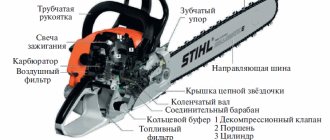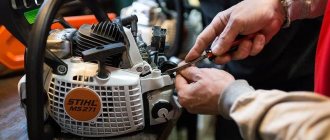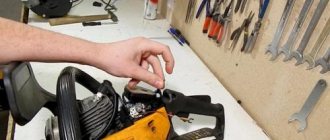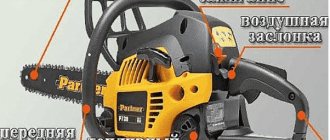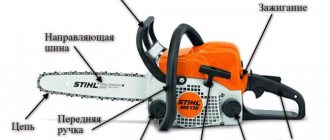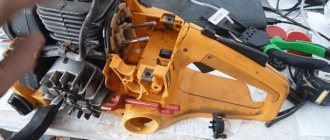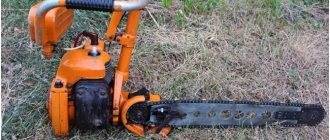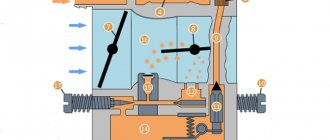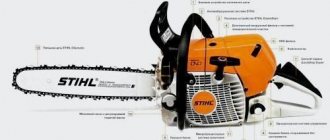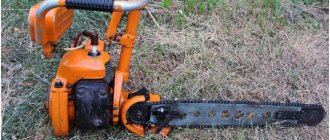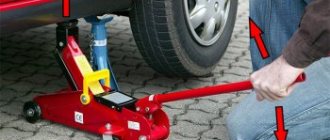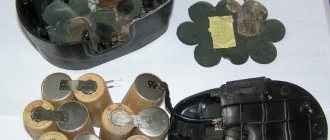Reasons why a chainsaw stalls under load
This article from the construction site remstroisovet.ru will discuss the main reasons why a chainsaw may not start or stall under load.
The most common reasons of all are the following:
— Blockage in the chainsaw carburetor - if the chainsaw carburetor is severely clogged, then the engine simply does not have enough fuel, and it begins to stall under load. Consideration of this problem will be described below, but for now we move on.
— The chainsaw carburetor sucks in air . This is also one of the common reasons why a chainsaw engine lacks power. It’s all about the gasket, or more precisely, its tightness.
— Problems with the chainsaw’s clutch can also lead to it starting to stall. It is very easy to damage, or in other words “break” the chainsaw’s clutch, and repairs will cost a pretty penny.
— Poor quality fuel mixture often causes chainsaw breakdowns. This is especially true for those moments when the chainsaw has not been used for a long time and gasoline has been poured into it. The old fuel mixture should be drained and a new one should be added, strictly maintaining the correct proportions of two-stroke oil for lubrication.
What causes a chainsaw to lose power?
— The power of the chainsaw is not enough . This, as it may seem at first glance, trivial option for considering the problem cannot be discarded. But if you are sawing an old dry acacia tree or a thick wet log with a chainsaw, then the engine simply may not have enough power. This is especially true in cases where the chainsaw chain is too dull and requires immediate sharpening.
— Incorrect adjustment of the chainsaw carburetor . If you have already adjusted the carburetor of a chainsaw, you might have done something wrong, as a result of which the chainsaw began to stall under load. It is better to re-adjust the chainsaw carburetor and repeat it several times on a “hot” engine and always during operation, so to speak, under “load”.
— The chainsaw fuel filter is clogged . The next problem due to which the chainsaw will certainly stall under load is a severely clogged fuel filter. Remember how long ago you changed the fuel filter on your chainsaw and did you change it at all? If it hasn't been changed for a long time, then you shouldn't even get into the carburetor, because it won't help at all. First replace the old fuel filter, and then, if the problem does not go away on its own, adjust the carburetor on the chainsaw.
The same applies to the air filter ; if this kind of problem occurs, it must be cleaned immediately. Now about the spark plug , if it is very dirty, it is also cleaned and adjusted if necessary. It is the incorrect gap between the electrode of the spark plug on a chainsaw that can lead to it starting to stall, and in general, to work extremely unstable.
No. 1. Chainsaw won't start
If difficulties arise with starting a chainsaw, many immediately blame the carburetor. In fact, there are several options and the cause of the malfunction can be any:
- Air and/or fuel filters are clogged. The problem can be solved by cleaning the filters.
- Lack of fuel in the tank. Yes, there is such a reason - some owners forget about such an insignificant detail as refueling a chainsaw and think that a couple of liters of gasoline will last for six months. In addition, fuel in the tank should not be stored for more than 14 days, because gasoline evaporates and the octane number is lost.
- Check the pipe from the fuel tank to the carburetor - it could be clogged or broken, so gasoline does not flow into the tank.
- There is no spark at the spark plug. Why there is no spark - there can be many reasons: there is no contact, the spark plug needs to be changed or it is flooded. Why the spark plug on a chainsaw fills is another question. But if this happens, you need to dry it and reinstall it, and then check for a spark. If there is heavy carbon deposits on the spark plug, it is recommended to replace it.
- Check the muffler for carbon deposits. If there is carbon deposits, thoroughly clean the muffler, but it is still recommended to take the chainsaw to a service center to have the cylinder and piston checked, because carbon deposits are a sure sign of improper operation of the elements of the cylinder-piston group.
- The carburetor is clogged. How to properly adjust a chainsaw so that the carburetor works well is discussed in a separate article.
If none of the above methods helped, then the reason is more serious - a breakdown of one of the connecting rod-piston group units. In this case, it is recommended to take the chainsaw to a service center.
The main reasons for chainsaw failure
Although the chain saw is a simple device, from time to time problems arise in its operation, which can only be eliminated by disassembling it. Examples include the following faults:
- the chainsaw does not gain speed;
- the chainsaw stops functioning when cutting;
- the chainsaw starts and stalls;
- the chainsaw loses its power;
- The chainsaw stalls when pressed.
Most often, malfunctions are associated with interruptions in the functioning of the motor, as well as with malfunctions of other systems and components. Proper handling of this equipment is of great importance. If all the rules of use are followed, problems with a high probability lie in the most obvious ones. When looking for the causes of problems, it is advisable to start by checking the simplest part of the chainsaw and finish with the most complex.
Why does a chainsaw stall when heating up?
The situation in which a chainsaw starts up when cold, but may stall while warming up, is familiar to many who deal with them. The main reasons for this behavior of the saw are as follows.
You can check the ignition coil using a multimeter or by replacing it with a known good one. Checking the primary and secondary windings with a multimeter is carried out in resistance measurement mode. The resistance of the primary winding, the working coil, is 1 kOhm - the secondary is 4 kOhm.
The chainsaw starts and stalls - the reason
If the chainsaw starts and stalls during the first attempts to do the job, then the reason may be problems with the chain brake or its jamming due to lack of lubrication. In this case, measure the oil level. If the amount of lubricant is sufficient, then the reason may lie in the tube that leads it to the lubrication mechanism.
Another reason could be a carburetor failure. If it only needs adjustment, you can do it yourself according to the instructions. If the carburetor needs cleaning or repair, then you cannot do without the help of professionals.
Another possible cause of this malfunction is a low fuel level in the tank. In this case, the chain saw stalls when tilted, since the remainder of the fuel mixture ends up in the part of the tank opposite to the place where the suction tube is located.
Why won't my chainsaw start?
If defects occur, it is necessary to check the serviceability of the components.
If a new chainsaw does not start, you should check the presence and supply of fuel, the occurrence of a spark on the spark plug, the functioning of the exhaust valve, and the condition of the filters. The operation of the saloon's stalling device built into the fuel cap may also be disrupted.
The reason that a Chinese chainsaw does not start may be poor-quality equipment. There may be various malfunctions or incorrect assembly. Some items arrive defective. If the inspection does not reveal any problems that you can fix yourself, you can replace the saw using the warranty card.
In the cold
The reason why the device does not start when cold is often a violation of the engine starting sequence.
You should read the instructions: manufacturers indicate how to properly start a chainsaw.
To enrich the fuel, you must first close the choke. After this, fuel is sucked in. A special primer is used for this. Then turn on the ignition. Before the engine fires for the first time, you need to make several movements of the starter. The damper opens and the device starts. If the sequence is broken or any step is skipped, incorrect operation may occur.
If your chainsaw stops starting, the likely cause is a problem with the fuel system. Starting problems can occur due to an incorrectly adjusted carburetor, clogged line and fuel filter. The quality of the fuel also matters. If the fuel is diluted with water, the device will start poorly or not work at all. The mixture must be fresh.
Read also: Who is a CNC operator?
A possible cause of problematic starting is an engine malfunction. Wear or breakage of a part leads to undesirable consequences: decreased compression in the cylinders and other troubles. It is recommended to contact specialists with such problems, since it is difficult to diagnose and correct the breakdown on your own.
Hot
If the chainsaw has difficulty starting when hot, you should begin inspecting the tool with the spark plug. You will also need to check the spark on the spark plug.
For the device to work properly, the spark plug must be dry. When it is wet, sparks do not occur at the contacts. You can try replacing the part with a new one.
If there is a spark and the spark plug is working properly, try looking for a problem in the fuel system. If a visual inspection fails to detect the cause of the breakdown, the carburetor should be removed. If the amount of fuel exceeds the permissible limit, the device will not work. The candle should be wet. The spark plug hole should be turned down. If the fuel mixture flows, the reason why the chainsaw does not start when hot is due to excess fuel.
No. 3. The engine "shoots"
If during operation there are extraneous sounds similar to gunshots, then there is a problem with the muffler or carburetor. How to make a chainsaw run quietly? It depends on which node is faulty.
Shoots the carburetor:
- Ignition is too late - the air-fuel mixture does not have time to burn out in the cylinder, so the sound is similar to a small explosion.
- Lean air-fuel mixture. Too little gasoline enters the mixture - the chainsaw, or rather the jets, needs to be adjusted to increase the fuel supply. Why the chainsaw revs on its own is for the same reason.
Shoots at the silencer:
- Enriched air-fuel mixture. Why does a chainsaw “shoot”? There is too much gasoline and not enough air in the mixture, so the mixture does not completely burn out in the chamber and partially burns out in the muffler. Carbon deposits on the exhaust are a clear sign of this. The air filter needs to be cleaned or the carburetor adjusted.
No. 2. The engine stalls
The engine starts, but the chainsaw stalls at idle or under load. In this case, most often you should perform the same actions as described above.
How to adjust a chainsaw depends on exactly when the problems start:
Stalls immediately after starting:
- The fuel mixture is not prepared correctly, there is too much oil in it, so the octane number of gasoline is less than it should be, so the chainsaw only runs on choke or stalls immediately.
- Carbon deposits on the spark plug or improper gap between the spark plug and the wire.
It stalls and does not work at idle:
- The muffler is clogged. It is necessary to remove carbon deposits.
- The carburetor settings are off. The idle speed on the chainsaw needs to be adjusted. This is done using adjusting bolts marked L and H. For how to adjust idle speed, see the article about adjusting the carburetor.
Stalls at maximum speed and only runs on choke
- The air or fuel filter is clogged. The seals need to be cleaned and checked.
- The breather is clogged and because of this, fuel does not flow and pumping gasoline on the chainsaw does not work. Take the needle and carefully clean the breather.
- Fuel pump malfunction. Remove the pump and check to see if gasoline is leaking from it. If it oozes, replace the sealing gasket or the pump itself.
The chainsaw does not cut under load and stalls
- The air filter is clogged. It is necessary to take out the filter, clean it well or even rinse it, dry it and install it back.
- Wrong proportion of oil/gasoline mixture. Drain the fuel and remix the oil and gasoline in the correct proportions.
Cleaning the fuel filter
If there is insufficient fuel supply, the chainsaw stalls when accelerating. The reason may be a clogged fuel filter and improper carburetor operation. How to check if the filter is at fault? To do this, you need to partially disassemble the tool body to gain access to the carburetor. Disconnect the fuel hose from it and press the fuel pump several times. On modern saws, this is a transparent rubber hemisphere that is pressed before starting the engine.
If gasoline begins to splash out of the hose vigorously, then the filter is in order. If fuel flows reluctantly, then you need to change or clean the filter.
It is located inside the gas tank, and to get it out, you need to remove the plastic protection, then use a flat screwdriver to pry off the rubber cuff through which the fuel line passes. You must remove it carefully so as not to damage the rubber. Otherwise, it will leak after installation. In some chainsaws, the filter is removed through the neck of the gas tank.
There is a fuel filter at the end of the fuel line installed in the tank. Usually it becomes clogged with tarry deposits found in gasoline and oil. The filter is pressed into the hose and can be removed by simply pulling it out. It must be washed in hot water with cleaning agents or replaced with a new one.
Checking and repairing filters
The engine may run rough or stall if there is not enough fuel or air. Causes: clogged air or fuel filter. To check the fuel filter, you need to remove the fuel line hose from the carburetor fitting and direct it into a container. Then press the fuel pump several times. If the fuel is pumped normally, in clearly defined doses, without dirt, then the fuel filter is working properly. If the stream is weak or fuel is not pumped at all, the filter needs to be replaced or, if possible, cleaned.
Clogging of the fuel filter with sawdust is one of the reasons for chainsaw breakdowns.
The device must be removed from the fuel tank (after draining all the fuel from it). On most models, the fuel filter can be pulled out with a wire hook through the neck. If the filter design is dismountable and can be cleaned, it must be disassembled and washed in accordance with the manufacturer’s recommendations. Otherwise, replace it with a new filter.
Similar problems can arise when the air filter is clogged with dust, sawdust, or dirt. If there is insufficient air, the fuel mixture will be enriched and the fuel combustion process will be difficult.
To check, remove the filter. During operation, precautions must be taken to prevent dust from entering the carburetor. The device must be cleaned and rinsed in warm water with added detergent. After drying, if possible, blow with low-pressure compressed air and reinstall. If the chainsaw works normally, then the cause has been eliminated; if not, you need to look further.
Read also: The disk drive on the computer does not eject
If the tool is used continuously, it is recommended to replace the filters of the fuel and air systems after 3 months.
How to adjust a chainsaw carburetor
To adjust the carburetor on a chainsaw, you need to have a small thin screwdriver and a few minutes of free time. It should be noted that after adjusting the carburetor, the engine may not behave as it should for some time, under load, for example, “cold” or “hot”.
To adjust the chainsaw carburetor, use two bolts on the side, one of which enriches the fuel mixture with oxygen, and the second regulates its amount in the combustion engine.
First, tighten the two screws until they stop, and then unscrew them until the chainsaw engine starts. Only after this should you tighten or unscrew each screw in turn until the chainsaw engine runs as stable as possible and without failures when you press the gas handle.
Why does a chainsaw stall when heating up?
It often happens that the chainsaw starts when cold, but stalls when it warms up. This behavior of the tool can be caused by the following reasons:
- The carburetor is not adjusted correctly. This problem can be identified by how the device starts up when cold. If it is carried out without closing the air damper, and the engine starts without a preliminary flash, this means that after the engine warms up, fuel floods the spark plug. The solution to this problem is to adjust the carburetor. Details about carburetor adjustment
- Malfunction of the coil (ignition module). This problem can be identified by sequentially checking the spark, first on a cold and then on a hot engine. If there is no spark on a hot engine, then you need to replace the ignition coil.
- Spark plug faulty. In this situation, as in the case of a faulty ignition module, the spark disappears when the engine heats up. You need to replace the spark plug with a new one, and if this does not solve the problem, you should check the ignition module and the distance between it and the flywheel.
Carburetor check and repair
The operating principle of a chainsaw carburetor.
If checking the ignition system, fuel filters, and muffler did not produce tangible results, the tool still does not want to work normally at minimum speed, you need to check the carburetor.
To adjust the operating modes, there are three screws on the device body designed to set the minimum rotation speed, maximum speed and idle speed.
On many models, manufacturers install only the idle air adjustment screw to avoid incompetent attempts to adjust the device. In all versions of the device, adjustment must be performed exactly according to the manufacturers' recommendations.
If adjusting the device does not restore normal operation of the instrument, you need to completely disassemble the device and inspect it. It should be understood that a carburetor is a rather complex device; if you lack experience, it is advisable to contact specialists.
When disassembling, it is important to carefully inspect and wash all jets, air and fuel channels, and filter mesh. Damaged elements must be replaced with new ones. The jets must be cleaned with soft wire of the appropriate diameter.
It is advisable to carry out work in appropriate conditions. The carburetor contains many small parts, the loss of any of them will render the device inoperable.
Why does a chainsaw stall under load?
Sometimes the chainsaw is unable to function properly under load. Most often this is caused by improper adjustment or leaking carburetor. In addition, the cause of this problem may be air leaks through the carburetor gasket or crankshaft oil seals. A tool that is unable to function under load will also not be able to reliably maintain idle speed.
Diagnostics begins with checking the carburetor and crankcase for leaks. If air leaks through the crankshaft oil seals are detected, they must be replaced. If air leaks are detected in the carburetor, installing a repair kit of gaskets is required to solve the problem.
If these actions do not lead to the desired result and the engine crankcase and carburetor are sealed, then you need to adjust the carburetor.
If a Husqvarna chainsaw stalls under load, then in case of any deviations in the functioning of the motor, you should first of all check the impulse hose, since this is the most common cause of failure of chainsaws of this brand.
What to do if your chainsaw stalls?
Builders, installers, rescuers and summer residents #8211 all of them, sooner or later, when performing their tasks, take up a chainsaw. And the final result of their activities largely depends on how reliably this tool works.
A chainsaw is used to cut wood.
It is worth noting that a chainsaw is a relatively simple device. Nevertheless, it, like other mechanisms, periodically fails. When a chainsaw stalls while idling (this is one of the most common malfunctions), the biggest problem #8211 is to determine the reasons for this behavior of the device. If the source of the “disease” is correctly identified ", returning the device to a working position will not be so difficult.
Therefore, the first thing you need to do is find out what malfunctions the chainsaw has and what leads to the engine stopping at idle.
Some maintenance tips
How do you solve problems with a chainsaw?
IndependentlyIn the service
Careful adherence to the operating and maintenance instructions for the tool is a guarantee of its long and trouble-free operation. It is worth considering that each part of the chainsaw has its own resource, so they need to be changed in a timely manner.
The rules for working with the tool are as follows:
- Before each installation, check that the chain is in good working order and has sufficient tension.
- Use only a well-sharpened chain for work.
- After using the saw, clean all components from sawdust.
- Rotate the tire for even wear. At the same time, lubricate the sprocket.
- If storing for a long time, drain the fuel and oil.
Store the chain and bar disassembled, as they form an electrochemical couple, and this leads to the formation of rust.
With improper operation and maintenance, not only budget-class instruments, but also quite prestigious models from well-known manufacturers are susceptible to spontaneous failures. To maintain the functionality of your chainsaw, follow the recommendations of professionals.
Chainsaw stalls at high speeds - simple carburetor repair
The carburetor of a tool is precisely the mechanism that most owners are afraid to disassemble on their own. The reason is that this mechanism consists of many small parts, the location of which must be remembered during dismantling work. However, not everything is as scary and difficult as it might seem. To understand how the carburetor relates to the problem of the engine stopping when the speed increases, you need to know its operating principle, described on the website.
The chainsaw stalls when you press the gas due to the carburetor if:
- Damaged membrane
- Clogged filter element (mesh in the carburetor). This malfunction may be encountered by tool owners who do not have a fuel filter or it is simply disconnected from the fuel hose.
- Needle sticking, which may be due to the use of an outdated fuel mixture
- Clogged jet channels or clogged carburetor
- Bending the connecting part that combines the membrane with the needle to supply fuel to the fuel chamber of the carburetor. This part is also called the foot, since under the influence of the membrane on it, the needle moves and the channel opens. During operation, this foot may bend (wear out) or break (if broken, the engine will not start). If the foot is bent, it can be straightened, but this does not guarantee that the problem will recur soon, so it is recommended to replace the part
It is recommended to clean and wash the chainsaw carburetor, as well as replace faulty parts and elements. After this, you can put it back, not forgetting to also replace (if worn) the sealing gasket between the carburetor and the adapter.
Why does the chainsaw not develop speed?
There may be several reasons for the lack of traction and poor speed of the chainsaw. Therefore, you should not immediately start disassembling and repairing the carburetor, since the reason may not be hidden in it.
The Shtil MS 180 chainsaw is equipped with a reliable carburetor, on which the manufacturer has limited the ability to adjust the power and maximum engine speed, so if the chainsaw loses traction, the carburetor is the last place to look for problems.
Muffler
You may ask, which is the first? The answer is a muffler. The muffler is responsible for exhaust gases and extinguishing the flames in them. All combustion products pass through it, which can clog it over time. The situation with a muffler clogged with soot is far from uncommon, and it occurs due to an incorrect fuel mixture.
With a normal ratio of gasoline to oil, combustion products are not so saturated with soot that they clog the muffler. If the amount of oil is more than normal, excessive carbon deposits will form during its combustion. Further, carbon deposits accumulate under the piston rings and in the muffler of the Stihl 180 chainsaw. Thus, a coked muffler is the most harmless thing that can happen, the maximum damage from excessive carbon deposits is the need to replace the piston.
How to check the muffler
To check the muffler, it must be removed from the chainsaw. To do this, using an 8 mm socket, unscrew the two fastening nuts and remove the part.
Important: after the muffler is removed, it is necessary to check the integrity of the gaskets between it and the cylinder, since very often they stick and break when the muffler is removed.
You can clean the part mechanically, using screwdrivers or a knitting needle, and then blow it thoroughly with compressed air. The seat on the muffler can be cleaned with sandpaper to remove burnt parts of the gasket.
The muffler must be installed in the reverse order.
Important: when tightening the muffler mounting nuts, do not over-tighten the nuts, as the threads on the screws can be stripped.
The second reason why a calm chainsaw engine may reduce power and not develop speed is a blockage in the fuel system. As a rule, the first place to start looking for a blockage is the fuel filter.
Checking the fuel filter
The fuel filter is installed in the tank of the Shtil 180 chainsaw, and it is not very convenient to remove it. To make the process easier, you can take a small piece of aluminum wire and bend it at the end, then use it to hook the fuel hose and remove it, along with the filter, from the tank. To check the filter, you need to blow into it; if air does not pass through, then the cause has been found, and the filter needs to be replaced.
If the filter is clean, you need to check the fuel hose for clogging. To check, you need to disconnect it from the carburetor and, with the air filter removed, blow into it. If a blockage is detected, you can clean the hose mechanically, using a wire, and then blow it out with compressed air.
Strainer in carburetor
The last likely place for a blockage to form is the strainer in the carburetor. In the diagram below, it is indicated by the number 13.
In order to clean the mesh filter, you need to remove the carburetor from the Shtil 180 chainsaw. The work begins by removing the top cover of the saw, after which, using an 8 mm socket, unscrewing the two fastening nuts. Next, the filter housing is removed from the guides, after which the air damper rod and the engine control lever are disconnected. Lastly, the fuel hose and throttle linkage are disconnected, after which the carburetor can be removed from the guides.
The carburetor strainer is installed in the fuel pump chamber; in order to get to it, one screw securing the pump cover is unscrewed and it, along with the gaskets, is removed.
The mesh filter can only be cleaned using compressed air. Any mechanical methods are strictly prohibited, since the mesh is very soft and easily changes shape. When you press it, it easily wrinkles and bends form along the edge of the seat, through which unfiltered fuel can enter the carburetor.
During the cleaning process, the seat with the filter installed in it must be half covered with your finger and only then blow with air, otherwise the mesh may fly away and it will no longer be possible to find it.
Carburetor depressurization and nozzle blockage
Sometimes, when the screws securing the carburetor cover are loose or the gaskets have become unusable, the chainsaw may also experience a loss of power. To eliminate the possibility of this malfunction, it is necessary to check the integrity of the gaskets and the tightness of the screws on the carburetor covers. To do this, you need to remove it from the engine (the algorithm is described above) and disassemble it. Defective gaskets must be replaced using spare ones from the repair kit for the Shtil MS 180 carburetor.
The saw stalls after releasing the gas
Here you need to adjust the carburetor and check for strong air leaks.
We have already seen the most common cases of chainsaw breakdowns. All that remains is to make sure that your saw will serve without breakdowns. But even such durable models as Shtil and Partner can sometimes fail.
Do not rush to immediately run to the service center, first use my advice, this way you can avoid large financial costs.
If you found the article interesting, share the tips with your friends via social networks. And I say goodbye to you. Good luck and see you again on the blog!
Malfunctions leading to improper operation of the chainsaw
There are a number of malfunctions that must be taken into account when diagnosing, since they can lead to interruptions in the operation of the saw.
- Wear of crankshaft bearings. If the crankshaft bearings are worn out, runout will inevitably appear on the main shaft where the flywheel is attached. In such a situation, it is impossible to adjust the gap between the flywheel and the ignition coil, which leads to interruptions in spark formation and unstable operation of the chainsaw.
- Impulse channel is dirty. The pulse channel serves to ensure the operation of the fuel pump; accordingly, its contamination will lead to improper operation of the pump, which will make it impossible for the saw to operate (it will start and immediately stall).
- CPG wear. As a rule, with increased wear of the CPG, a decrease in compression in the chainsaw engine is observed, which will certainly affect its ability to develop speed.
- Dirty fuel and air filters.
The reason for the chainsaw stopping in the midst of work may be:
- poor quality of components and entire units;
- unskilled care;
- use of low-quality fuel and oil substitutes;
- illiterate operation.
The distance from service departments and the high cost of the repair services provided force owners of failed tools to restore their functionality on their own.
This option is only possible after the warranty period has expired. The difficulty lies in the fact that traces of dismantling of individual components and assemblies noticed by service specialists may be the reason for refusing free repairs of more complex and expensive parts.
Read also: DIY dump trailer for walk-behind tractor
